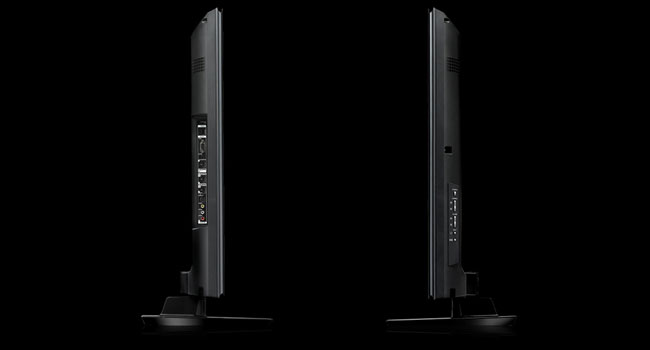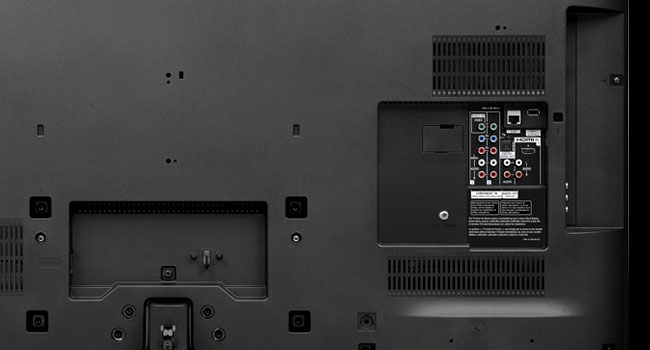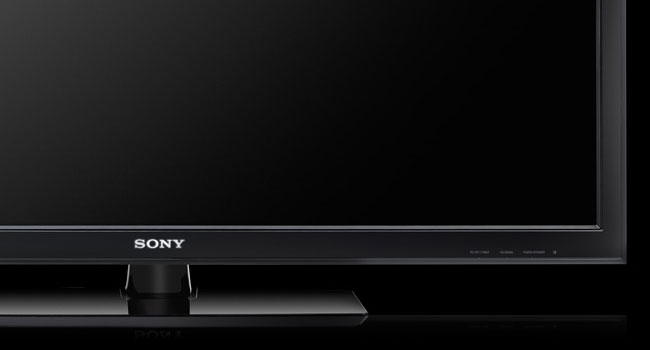“Although they lack LED backlighting, the reasonable price tags on Sony's XBR9 televisions and deluxe features make them a bargain.”
- Superb picture quality
- Minimal motion blur
- Plethora of Internet-connected features
- Deeply discounted
- Comfortable, intuitive remote
- Three of four HDMI inputs on the side
- Understated, non-swiveling bezel
- Yahoo Widgets currently less than useful

Introduction
LED backlighting may be the wave of the future, but Sony seemed to take a little longer figuring it out than everyone else. After introducing the hyper-efficient new technology in its top-tier Bravia XBR8 sets in 2008, it nixed the technology in favor of standard CCFLs for the XBR9 at the beginning of 2009, then recently returned to LEDs for the XBR10. The resulting 52-inch XBR9 stands out as an anomaly in the fabled XBR legacy, but one that Sony has already atoned for in price: the set that debuted in the Spring for $3,600 can now be had for $2,300 directly from Sony. Does the price drop justify picking up last-gen backlighting in an otherwise ultra-modern set? We put the XBR9 to the test to find out.
Features
Short of LED backlighting, the XBR9 includes just about everything you would expect from Sony’s latest and greatest set, including a 240Hz refresh rate, 100,000:1 dynamic contrast ratio, BRAVIA Engine 3 processor, 10-bit panel, and perhaps the most significant addition, built-in internet video capability and widgets. That means the ability to stream everything from Slacker Internet radio to YouTube videos without any additional hardware, plus news, weather, stocks and other info layered right over your whatever you’re watching, in an instant.
Dimensions and Weight
Even without the slimming effects of LED backlighting, the XBR9 manages to get even thinner than its predecessor: just 59mm compared to 147mm on the chunky 55-inch XBR8. That’s nowhere near the super-slim leaders of the thin movement, but attractive enough to our eyes. Weight stands at 71.4 pounds with the pedestal, or 62.2 without.

Design
In contrast to the glass-trimmed XBRs of years past, the XBR9 looks downright conservative. A slim stripe of smoked acrylic runs along all four edges, looking gloss black for the most part until it reaches the outer quarter inch, where the backing falls away to show off its translucence. The effect is so subtle it might be taken for yet another gloss-black bezel at first glance. The rather plain pedestal didn’t do much for us, either, and it doesn’t swivel. Fans of conservative styling can chalk this one up to a win, but those who need that extra glint of style to reaffirm that they’ve sprung for the XBR will be disappointed.
Ports and Connections
As you might expect from a high-end HDTV, the XBR9 comes equipped with a healthy selection of inputs and connectors. As you might not expect, many of them come on the side, including three of the four HDMI ports, the only S-video connection, the only composite video connection, the only USB connection, and the only VGA connection. Although recessing the side connection panel about three inches back from the edge of the bezel helps mask the tangle of cords running to it, we still would have preferred more of the connections on the back, where the cables look more discreet. The back houses many of the more obscure ports, including two component video connections, optical and analog audio out, and the Ethernet jack.

Performance
Even without LED backlighting, the XBR9 is still an XBR, and it lives up to its top-shelf status in picture quality.
While many TVs come quite amped up with unrealistic color right out of the box, the XBR9 actually delivers excellent settings in Standard video mode. A thorough calibration with Spears & Munsil’s benchmark Blu-ray and Oppo’s BDP-83 required very few changes for proper adjustment.
In movies, skin color struck us as spot on, lacking the blushed look or pale blue tinge extreme that less quality sets are prone to, and black levels were excellent. Does it accomplish the abyss-like depth that LED-backlit sets with localized dimming and the best plasmas pull off? Not quite, but for the price level, it gets pretty damn close.
Like most sets with refresh rates over the standard 60Hz, the XBR9 includes options for inserting artificial in-between frames above and beyond what the source material actually offers, in order to generate smoother motion. Sony calls this option CineMotion, and offers it in two flavors: Auto 1 and Auto 2. CineMotion managed to improve motion without causing it to look unnatural in both doses, which is more than can be said about similar options from many manufacturers. That said, the effect is also more subtle.
We fired up Call of Duty 4 on Xbox 360, to test the XBR9’s 240Hz refresh rate with fast-motion scenes. While jerking around the view in scenes with stark contrast (a light character against a dark background) caused some extremely minor smearing, the effect was barely noticeable compared to other sets, including some 120Hz models such as Insignia’s NS-L42X (which would be on the extreme low-end of the spectrum).
Sound Quality
Most of the home theater aficionados even eying an XBR will probably want to pair the XBR9 with a high-end audio system, but the sound that the humble built-in speakers manage to crank out is surprisingly good. Forgiving the lack of bass that has to be expected for any built-in speakers, the rear-firing drivers deliver plenty of grunt most of the way up to maximum volume, at which point distortion is evident. Sony also includes a comprehensive sound adjustment menu that offers access to everything from basic bass and treble to a full-blown equalizer and advanced settings like voice zoom.
Internet Video and Widgets
Like nearly every crop of Internet-connected television, Sony’s XBR9 includes Yahoo Widgets to push information like stocks, weather and news to your screen in modular overlays – toys you might dabble with during a commercial break, as opposed to full-function tools. Pressing “widgets” on the remote brings your customized mix of widgets up as icons across the top of your screen, any of which you can select and pull down to occupy about a third of the screen. We liked the unobtrusive nature of the widgets, but many proved too shallow to be useful; News, for instance, displays only headlines and one-sentence summary of articles, with no option to read the entire thing. Find an interesting story? Too bad, just a teaser. And at the time of publication, the only nine widgets comprised the entire library – a pretty sad offering for a system going on a year old.
Fortunately, Sony’s built-in video options proved more robust. It includes a lengthy list of continuously updated content providers including YouTube, Netflix, Crackle, Yahoo and more. Some, like Blip.tv, offer a whole bundle of sub channels within that provide even more. Although quality varies widely from service-to-service, the breadth of content kept us thoroughly entertained without a cable connection – to us, that makes it a feature we would be willing to shell out extra for, especially given the hassle-free experience. That being said, the sub-par quality found in virtually all the Internet video selections can’t help but feel like a waste of a beautiful TV that’s capable of much more. And we hope that Sony can iron out content deals with other partners – like Hulu – to really round out the selection.

Menus and Interface
Much like the PlayStation 3 and previous iterations of the XBR, the XBR9 uses Sony’s long-standing Xross Media Bar menu system. For those not familiar with it, that means media-oriented features like photo viewing, video and music end up arrange in a horizontal line across the screen, with sub-selections lined up perpendicular to each option when you scroll over it. It’s clean, intuitive, and efficient to navigate. We like it.
That impression largely carries over to the rest of the menu system as well, which has the refined feel of a gaming system. Pull up the list of inputs, for instance, and the TV greys out those without signal, making it easier to select the right one.
Remote
At 10 inches long and about an inch thick, the remote that comes with the XBR9 is a whopper. Fortunately, its relatively light weight makes it less unwieldy in actual use than the size would suggest.
If you want to make use of the XBR9’s most advanced features, like Internet video, you can expect to spend as much time thumbing through XBR9 menus as flipping channels. That makes the center directional pad critical, and it’s up to the task. A ring of shortcut buttons surround the D-pad, such as “favorites” and “home,” also come in handy. The central location of the pad and a cutout for the index finger below also make the remote comfortable to hold in this position. Unfortunately, the channel-flipping and volume buttons have been shoved all the way to the bottom as a result, making that function a little less palatable. Although the upper portion of the remote can look crowded at first glance, we memorized the location of the frequently used “widgets” and “video” buttons pretty quickly, and the remote’s brilliant blue backlighting makes them easier to sort out at night.
Conclusion
Don’t let the lack of LED backlighting deter you from the XBR9, especially if you’re on a budget. As the generations of top-notch XBR sets before it attest, Sony knows how to build a quality CCFL-backlit LCD television, and the XBR9 is no exception. Besides outstanding picture quality, the XBR9 offers built-in Internet connectivity and other lush features you would expect from an XBR, for far less than either of Sony’s older or newer LED-backlit alternatives. It’s the BMW M3 sedan of televisions: The cheapest M-series BMW makes, but still a freakin’ M-series.
Highs:
- Superb picture quality
- Minimal motion blur
- Plethora of Internet-connected features
- Deeply discounted
- Comfortable, intuitive remote
Lows:
- Three of four HDMI inputs on the side
- Understated, non-swiveling bezel
- Yahoo Widgets currently less than useful
Editors' Recommendations
- Sony’s best soundbars are reborn as the Bravia Theater Bar 8, Bar 9, and Quad
- Sony’s Bravia Core gets a new name, and new PS4/PS5 apps
- Sony releases its 2023 TV prices with one very big exception
- All Sony Bravia 2022 TV prices announced, including the QD-OLED A95K
- Sony is updating 2021 Bravia TVs with variable refresh rate


